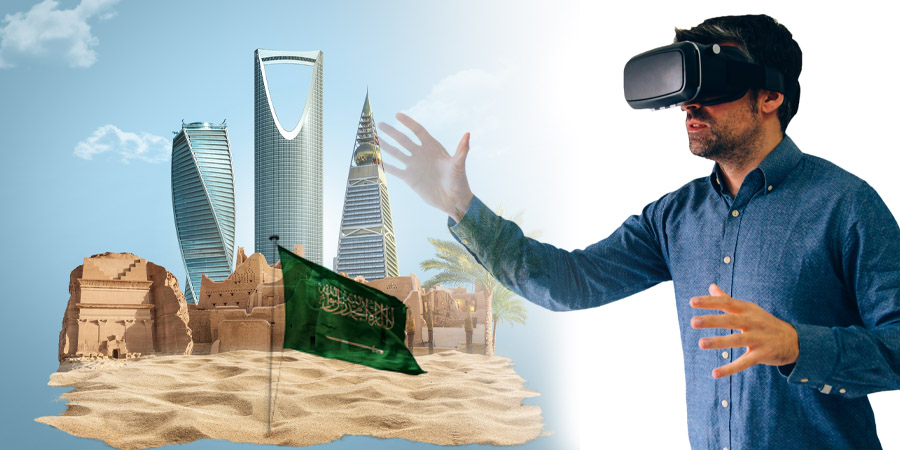Saudi Arabia, driven by its ambitious Vision 2030 initiative, is bound to lead in harnessing immersive technologies like virtual reality (VR), augmented reality (AR), and the metaverse to revolutionize cultural experiences. By integrating these advanced technologies, the Kingdom aims to enrich cultural offerings that resonate deeply with both local residents and global visitors.
According to the Digital Tourism 2023 report by MCIT and the Technology Foresight Center, technological advancements in the tourism sector are set to play a pivotal role, extending the boundaries of traditional tourism experiences. Through immersive technologies, tourists can explore destinations without limitations, enhancing their engagement and understanding.
Saudi Arabia's digital tourism strategy encompasses various initiatives slated for implementation through 2025. These initiatives aim to foster a smart working environment conducive to digital transformation within the tourism sector.
At the core of this transformation lies a robust digital infrastructure.
Components such as fiber connectivity, 5G networks, cloud infrastructure, ethernet connections, satellite connectivity, edge data centers, Internet of Things (IoT) devices, and microwave links form the foundational backbone. This infrastructure supports seamless connectivity and efficient data transmission across destinations, underpinning the Kingdom's vision for a digitally-enhanced tourism experience.
Saudi Arabia Tourism Market Drivers
Saudi Arabia’s tourism sector is flourishing, with the Kingdom welcoming 30 million foreign visitors in 2024, according to an Emirates NBD Research report. This marks a 9% increase from the 27.5 million international arrivals recorded in 2023.
Data from the Ministry of Tourism further highlights this growth, revealing that 17.5 million international tourists visited Saudi Arabia between January and July in 2024 alone—an increase of 10% compared to the same period in 2023 and a remarkable 73% surge from pre-pandemic figures in 2019.
A particularly striking trend is the explosive growth in entertainment and holiday tourism. Between 2019 and 2023, the number of visitors traveling for leisure surged by 656%. In the first seven months of 2024, 4.2 million tourists arrived for entertainment and holiday purposes, marking a 25% increase from the previous year and underscoring Saudi Arabia’s appeal as a globally recognized destination.
The integration of immersive technologies into Saudi Arabia’s tourism sector represents a paradigm shift, offering visitors deeper, more interactive experiences while safeguarding the Kingdom’s rich cultural heritage.
Through Vision 2030, Saudi Arabia is leveraging virtual reality (VR), augmented reality (AR), and the metaverse to transform architectural tourism, ensuring that its historical and modern landmarks remain accessible to global audiences in innovative ways.
Artificial intelligence (AI) is also playing a crucial role in enhancing Saudi Arabia’s tourism ecosystem. AI-driven solutions personalize visitor experiences, optimize travel routes, and provide interactive historical tours. Flagship projects such as NEOM and the development of UNESCO World Heritage sites like AlUla and Diriyah further highlight the Kingdom’s commitment to using AI and emerging technologies to offer tailored, immersive tourism experiences.
Immersive Applications in Saudi Tourism
Saudi Arabia is rapidly expanding its use of immersive technologies to enhance tourism, cultural heritage, and entertainment experiences.
- Saudi Arabia is leveraging AR to enhance on-site experiences. In January, 2024, ARway.ai partnered with AI Safer to introduce interactive wayfinding and immersive content at Saudi museums and tourist sites. The platform enables visitors to navigate spaces using phone cameras while accessing location-based digital information.
- The cultural metaverse is also taking shape. In February, 2024, the Ministry of Culture launched the world’s first National Cultural Metaverse Platform, offering immersive virtual tours powered by Generative Media Intelligence (GMI). This initiative ensures accessibility across mobile, VR, and desktop devices, allowing global users to explore Saudi Arabia’s rich history.
- Expanding its digital presence, Saudi Arabia introduced several groundbreaking virtual experiences. The King Abdulaziz Center for World Culture (Ithra) launched the third edition of its Creative Solutions initiative in March, 2024, fostering talent in digital art and immersive storytelling. Meanwhile, the Saudi National Museum debuted a 3D virtual tour, enabling users to explore historical artifacts interactively.
- In September, 2024, the Ministry of Tourism signed a Memorandum of Cooperation (MoC) with the Saudi Authority for Data and Artificial Intelligence (SDAIA). This partnership aims to establish an AI Center of Excellence (CoE) for tourism, leveraging data analytics and AI-driven insights to optimize visitor engagement and sector growth.
- November, 2024, marked a major step in AI-driven tourism with the Saudi Tourism Authority (STA) unveiling SARA, an AI-powered virtual travel assistant. Designed to enhance visitor experiences through real-time insights on cultural sites and attractions, SARA reflects Saudi Arabia’s commitment to smart tourism and interactive digital services.
- In January, 2025, the General Entertainment Authority (GEA), in collaboration with the Ministry of Investment, outlined 29 investment opportunities across Saudi Arabia’s entertainment sectors. Available on the ‘Invest Saudi’ platform, these projects aim to attract global investors and include plans for a VR-based entertainment park, an e-gaming center, and various amusement and adventure parks.
- AlUla made history by becoming the first UNESCO World Heritage site to enter the metaverse. The Royal Commission for AlUla (RCU) created a digital twin of Hegra’s Tomb of Lihyan using Decentraland, enabling virtual tourists to explore the site in 360-degree detail.
- In Diriyah, a 6,550 sqm digital art institute, Diriyah Art Futures (DAF), was launched, featuring immersive labs, film studios, and interactive exhibition spaces. Additionally, Mada’in Saleh and Hegra’s Tomb of Lihyan now offer digital twin models, allowing virtual visitors to explore these UNESCO World Heritage sites remotely.
- The Kingdom is also using VR to bridge spiritual tourism gaps. Platforms like Bigitec Studio and Labbaik VR provide detailed simulations of the Kaabah, enabling users to experience the Hajj pilgrimage
- Further embracing the metaverse, Saudi Arabia’s Deputy Minister of Culture, Hamed bin Mohammed Fayez, introduced ‘Kawen,’ a cultural platform featuring avatar-based historical tours, music events, and art exhibitions.
- Saudi Arabia’s Public Investment Fund (PIF) also entered the immersive entertainment sector by launching the National Interactive Entertainment Company (QSAS). This entity will develop world-class interactive exhibitions inspired by Saudi heritage and Islamic history, initially for domestic audiences before expanding globally.
These initiatives leverage advanced digital technologies to enhance tourism, preserve cultural heritage, and drive economic diversification, aligning with Saudi Arabia’s strategic vision. With immersive experiences at the forefront, the Kingdom is redefining global tourism in the digital age.
2030 Outlook
Saudi Arabia’s meteoric rise as a global tourism powerhouse is a testament to the Kingdom’s ambitious Vision 2030 strategy. According to the United Nations World Tourism Organization (UNWTO), Saudi Arabia now ranks third worldwide in international visitor arrivals—a remarkable achievement driven by strategic policies and unwavering commitment from both the public and private sectors.
The Kingdom’s ability to surpass expectations is evident in its tourism milestones. In 2023, Saudi Arabia met its goal of attracting 100 million annual visitors—seven years ahead of schedule. Now, it intends to attract 150 million tourists by 2030. To do so, the country is accelerating investment in infrastructure, innovation, and digital transformation to redefine global tourism experiences.
Artificial intelligence (AI) has become a cornerstone of this transformation, enhancing travel planning, MICE (meetings, incentives, conferences, and exhibitions), and the broader hospitality industry. Local travel agencies and tourism stakeholders are leveraging AI to personalize guest experiences, streamline operations, and elevate service standards.
The role of immersive technology in tourism is also expanding rapidly. A report by Strategy& predicts that the metaverse could contribute up to USD 15 billion to GCC economies by 2030, with Saudi Arabia accounting for USD 7.6 billion of this total. From digital heritage preservation to interactive travel planning, the Kingdom is embracing emerging technologies to enhance accessibility and engagement for global audiences.
With strong momentum and a clear vision, Saudi Arabia is not just reshaping its tourism sector; it is redefining the global travel experience.
By blending cultural heritage with cutting-edge innovation, the Kingdom is on track to solidify its position as a premier international destination for decades to come.
More Insights to Explore:
Virtual Reality: The Future of Immersive Experiences
Are We Heading Towards a Mixed Reality Future?
How the World Wide Web is Fueling Today’s Digital Lifestyle and Connectivity











